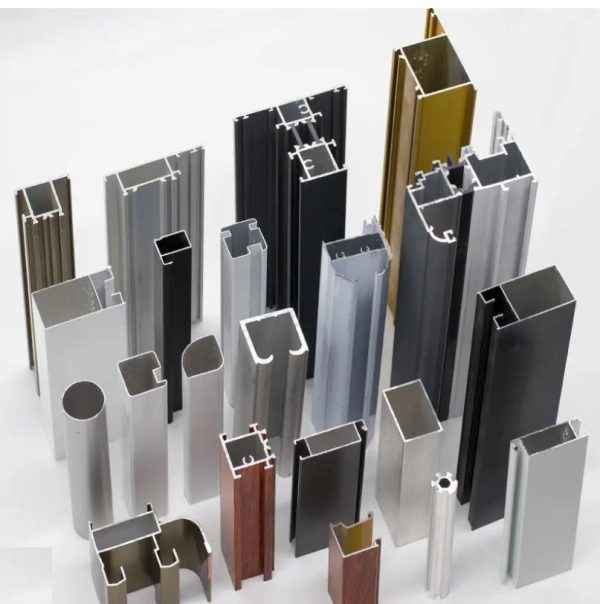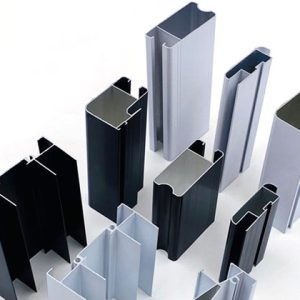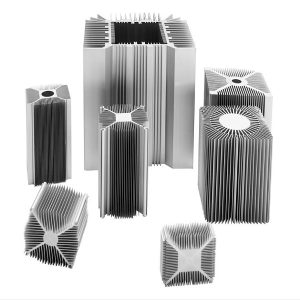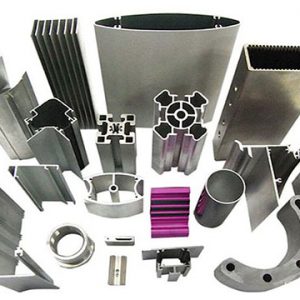apibūdinimas
6061 ir 6063 yra du įprasti tipai aliuminio profiliai naudojamas įvairiose pramonės šakose.
6061 Aliuminio profiliai yra žinomi dėl savo stiprumo, ilgaamžiškumą, ir atsparumas korozijai. Jie dažnai naudojami programose, kur reikalingas didelis stiprumas ir standumas, tokių kaip aviacijos ir kosmoso, automobilių, ir struktūrinė inžinerija. 6061 Aliuminio profiliai turi puikų apdirbimą ir juos galima lengvai suvirinti, Padarykite juos populiariu pasirinkimu pagal užsakymą.
6063 aliuminio profiliai, iš kitos pusės, yra žinomi dėl puikių apdailos savybių ir estetinio patrauklumo. Jie dažnai naudojami programose, kur svarbi išvaizda, pavyzdžiui, architektūrinės ir dekoratyvinės programos. 6063 Aliuminio profiliai turi gerą atsparumą korozijai ir juos lengva išspausti, Padaryti juos populiarų pasirinkimo pasirinkimą.
Abu 6061 ir 6063 aliuminio profiliai yra universalūs ir gali būti naudojami įvairiose programose. Pasirinkimas tarp dviejų priklauso nuo konkrečių programos reikalavimų, tokios kaip stiprybė, ilgaamžiškumą, ir išvaizda.
Kaip pagrindinis pažangių ir labai specializuotų aliuminio išspaudimų profilių gamintojas. Siūlome asortimentą pritaikytų aliuminio profilių, aliuminio ekstruzijos, ir didelė struktūrinė ekstruzija. Aliuminio profiliai idealiai tinka mašinų ir įrenginių konstrukcijoms. Didelis privalumas – mažas profilių svoris ir lanksti sujungimo technologija.
6061 6063 Aliuminio profiliai Gamintojas Rayiwell MFG iš Kinijos. Aliuminio profiliai galima padalyti į 1024, 2011, 6063, 6061, 6082, 7075 ir kitų aliuminio profilių lydinių, Iš kurių 6 serija yra labiausiai paplitusi. Skirtingų rūšių skirtumas yra tas, kad skirtingų metalinių komponentų santykis yra skirtingas, Išskyrus dažniausiai naudojamus aliuminio profiliai Durys ir langai Be architektūrinių aliuminio profilių, tokių kaip 60 serija, 70 serija, 80 serija, 90 serija, ir užuolaidų sienų serija, pramoniniams aliuminio profiliams nėra aiškaus modelio skirtumo, ir dauguma gamintojų juos apdoroja pagal faktinius klientų brėžinius.
Aliuminio profiliai turėti tokį paviršiaus apdorojimą
1. Anoduotas aliuminis
2. Elektroforetinė aliuminio danga
3. Milteliniu būdu dengtas aliuminis
4. Medienos grūdų pernešimo aliuminis
5. Fluoroangliavandeniu purškiamas aliuminis
6. Poliruotas aliuminis (skirstomi į mechaninį poliravimą ir cheminį poliravimą, tarp kurių cheminis poliravimas yra brangiausias ir brangiausias)
Aliuminio profiliai yra produktai, gimę iš aliuminio lydinių, kurie per ekstruzijos procesą virsta suformuotais objektais. Unikalus aliuminio fizinių savybių derinys labiausiai priklauso nuo šio proceso. Aliuminio ekstruzijos naudojamos keliose srityse, nes šis metalas yra: Stiprus ir stabilus.
Aliuminio profilių tipai
- Tuščiaviduris sija.
- Kvadratinis profilis.
- SD aliuminio profilis.
- RCW profilis.
- Durų sekcija.
- Žaliuzės profilis.
- T sekcija
-
lydinys ir fe su MN mg kr zn ti Priemaiša al Vienetas Iš viso 6063 0.2-0.6 <0.35 <0.1 <0.1 0.45-0.9 <0.1 <0.1 <0.1 <0.05 <0.15 Perteklius 6061 0.4-0.8 0.7 0.15-0.4 <0.15 0.8-1.2 0.04-0.35 <0.25 <0.15 <0.05 <0.15 Perteklius 6005 0.6-0.9 <0.35 <0.1 <0.1 0.4-0.9 0.1 <0.1 <0.1 <0.05 <0.15 Perteklius 6060 0.3-0.6 0.35-0.6 0.1-0.3 <0.1 <0.1 <0.15 <0.05 <0.1 <0.05 <0.15 Perteklius - Tipiškas naudojimas 6061 Atstovaujančios programos apima aviacijos ir kosmoso įrenginius, elektros įrenginiai, Ryšiai, ir taip pat yra plačiai naudojami automatinėse mechaninėse dalyse, precizinis apdirbimas, formų gamyba, elektronika ir tikslūs prietaisai, SMT, PC plokštės litavimo transporto priemonės, ir tt.
aliuminis Produktai, pagaminti iš aliuminio ir kitų lydinių elementų. Paprastai jis perdirbamas į liejinius, kaltiniai, folijos, plokštės, juostelės, vamzdžiai, strypai, profiliai, ir tt, o po to apdorojamas šalto lenkimo būdu, pjovimas, gręžimas, surinkimas, ir dažymas. Pagrindinis metalo elementas yra aliuminis, pridedant kai kurių lydinio elementų, siekiant pagerinti aliuminio veikimą
Aliuminio profilio išspaudimas yra gamybos procesas, apimantis sudėtingų formų ir dizainų sukūrimą naudojant aliuminį kaip pagrindinę medžiagą. Procesas apima išlydyto aliuminio verčia per štampą, kuris yra specialiai suprojektuotas įrankis, formuojantis aliuminį į norimą profilį.
Aliuminio profilio išspaudimo procesas prasideda nuo štampo sukūrimo, kuris paprastai gaminamas iš plieno ar kitos patvarios medžiagos. „The Die“ yra sukurtas siekiant sukurti norimą gatavo produkto formą ar profilį. Kai sukuriamas štampas, Jis sumontuotas ant spaudos ir kaitinamas iki pakankamai aukštos temperatūros, kad ištirptų aliuminis.
Tada aliuminis įkeliamas į bunkerį, kuris jį maitina spaudai. Spauda taiko slėgį išlydytam aliuminiui, priversdamas jį per štampą. Kai aliuminis praeina per štampą, Jis atvėsinamas ir sukietėjęs, formuojant norimą formą ar profilį.
Išspaudus aliuminį, Jis supjaustomas iki norimo ilgio ir gali būti papildomas, pavyzdžiui, paviršiaus apdaila, apdirbimas, ar susirinkimas. Gauti aliuminio profiliai gali būti naudojami įvairiose programose, įskaitant statybą, automobilių, Aviacija, ir vartojimo produktai.






-
-
-